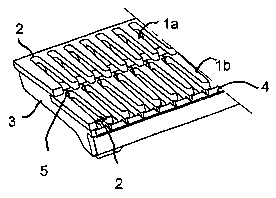Some of the information on this Web page has been provided by external sources. The Government of Canada is not responsible for the accuracy, reliability or currency of the information supplied by external sources. Users wishing to rely upon this information should consult directly with the source of the information. Content provided by external sources is not subject to official languages, privacy and accessibility requirements.
Any discrepancies in the text and image of the Claims and Abstract are due to differing posting times. Text of the Claims and Abstract are posted:
| (12) Patent Application: | (11) CA 2446466 |
|---|---|
| (54) English Title: | BAR SCREEN MODULE OF A VIBRATORY FEEDER |
| (54) French Title: | MODULE DE GRILLES A BARREAUX D'UN ALIMENTATEUR VIBRANT |
| Status: | Deemed Abandoned and Beyond the Period of Reinstatement - Pending Response to Notice of Disregarded Communication |
| (51) International Patent Classification (IPC): |
|
|---|---|
| (72) Inventors : |
|
| (73) Owners : |
|
| (71) Applicants : |
|
| (74) Agent: | OSLER, HOSKIN & HARCOURT LLP |
| (74) Associate agent: | |
| (45) Issued: | |
| (86) PCT Filing Date: | 2002-05-17 |
| (87) Open to Public Inspection: | 2002-12-12 |
| Examination requested: | 2003-12-05 |
| Availability of licence: | N/A |
| Dedicated to the Public: | N/A |
| (25) Language of filing: | English |
| Patent Cooperation Treaty (PCT): | Yes |
|---|---|
| (86) PCT Filing Number: | PCT/FI2002/000422 |
| (87) International Publication Number: | WO 2002098584 |
| (85) National Entry: | 2003-11-05 |
| (30) Application Priority Data: | ||||||
|---|---|---|---|---|---|---|
|
This invention relates to a bar screen module of a vibratory feeder,
comprising screen bars (1) extending in moving direction of a material, and
screen apertures (2) arranged between the bar screens to enlarge wedge-
shapedly in the moving direction of the material. The invention is
characterized in that the upper part of each screen bar (1) is divided in the
moving direction of the material into at least two parts (1a,1b) extending on
different levels, whereby all upper surface parts (1a and 1b, respectively) of
each level of the bar screen module form a stair step extending on the level
in question transversely to the moving direction of the material.
L'invention concerne un module de grilles à barreaux d'un alimentateur vibrant, comprenant des grilles à barreaux (1) s'étendant dans un sens de déplacement d'un matériau, et des ouvertures (2) de trames ménagées entre les grilles à barreaux de manière à permettre l'élargissement en biseau dans le sens de déplacement du matériau. Le mode de réalisation décrit dans cette invention se caractérise en ce que la portion supérieure de chaque grille à barreaux (1) soit divisée dans le sens de déplacement du matériau en au moins deux parties (1a, 1b) qui s'étendent sur différents niveaux, toutes les parties de surface supérieures (1a et 1b, respectivement) de chaque niveau du module formant une marche qui s'étend sur le niveau en question transversalement au sens de déplacement du matériau.
Note: Claims are shown in the official language in which they were submitted.
Note: Descriptions are shown in the official language in which they were submitted.

2024-08-01:As part of the Next Generation Patents (NGP) transition, the Canadian Patents Database (CPD) now contains a more detailed Event History, which replicates the Event Log of our new back-office solution.
Please note that "Inactive:" events refers to events no longer in use in our new back-office solution.
For a clearer understanding of the status of the application/patent presented on this page, the site Disclaimer , as well as the definitions for Patent , Event History , Maintenance Fee and Payment History should be consulted.
| Description | Date |
|---|---|
| Inactive: Agents merged | 2013-10-24 |
| Application Not Reinstated by Deadline | 2006-05-17 |
| Time Limit for Reversal Expired | 2006-05-17 |
| Inactive: IPC from MCD | 2006-03-12 |
| Deemed Abandoned - Failure to Respond to Maintenance Fee Notice | 2005-05-17 |
| Letter Sent | 2004-01-23 |
| Inactive: Cover page published | 2004-01-16 |
| Letter Sent | 2004-01-14 |
| Inactive: Notice - National entry - No RFE | 2004-01-14 |
| Request for Examination Requirements Determined Compliant | 2003-12-05 |
| All Requirements for Examination Determined Compliant | 2003-12-05 |
| Request for Examination Received | 2003-12-05 |
| Application Received - PCT | 2003-11-25 |
| National Entry Requirements Determined Compliant | 2003-11-05 |
| Application Published (Open to Public Inspection) | 2002-12-12 |
| Abandonment Date | Reason | Reinstatement Date |
|---|---|---|
| 2005-05-17 |
The last payment was received on 2004-05-11
Note : If the full payment has not been received on or before the date indicated, a further fee may be required which may be one of the following
Please refer to the CIPO Patent Fees web page to see all current fee amounts.
| Fee Type | Anniversary Year | Due Date | Paid Date |
|---|---|---|---|
| Basic national fee - standard | 2003-11-05 | ||
| Registration of a document | 2003-11-05 | ||
| Request for examination - standard | 2003-12-05 | ||
| MF (application, 2nd anniv.) - standard | 02 | 2004-05-17 | 2004-05-11 |
Note: Records showing the ownership history in alphabetical order.
| Current Owners on Record |
|---|
| METSO MINERALS (TAMPERE) OY |
| Past Owners on Record |
|---|
| REIJO KALEVI KANKAANPAA |